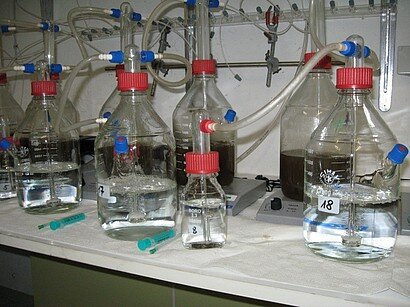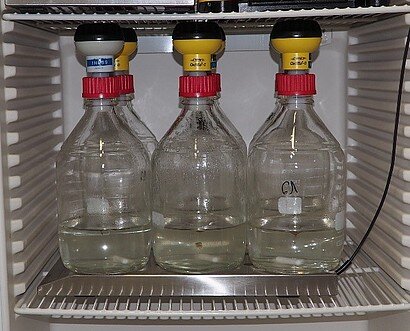
Zahn-Wellens-Test
OECD 302 B, Regulation (EC) No 440/2008, C.9, DIN EN ISO 9888, German Wastewater Ordinance No. 406, 407, 408
A) Single substance test
The “Zahn-Wellens test” is a classical test to determine the inherent (in principle possible) degradability of water-soluble, non-volatile organic substances. The test substance is incubated in a mineral medium with relatively high amounts of activated sludge (0.2 to 1.0 g/l) as inoculum during 28 days as a batch test. The test concentration varies between 50 and 400 mg/l DOC or 100 and 1000 mg/L COD, respectively. Samples are taken in regular intervals and the decrease of DOC or COD in the filtrated samples is measured over time. The portion adsorbed to the sludge is estimated from a sample taken after 3 hours. It will be used also as a reference value for the calculation of the biological degradability. At the same time, the blank value of the activated sludge, the degradability of a reference substance and the abiotic elimination of the test substance (intoxicated sample without activated sludge) are each determined in at least one additional test vessel.
B) Wastewater evaluation
Concerning wastewaters, the „Zahn-Wellens test“ is used to determine the refractory (slowly degradable) COD or DOC. The test design corresponds to that used for the single substance test. Elimination extents are related to the (calculated) COD or DOC values, respectively, at test begin while considering the stripped part (as determined in the abiotic control). Due to the fact that it is not possible to distinguish between elimination caused by biological degradation and adsorption-induced elimination, the test result is defined as "elimination extent”. Two different test versions are used:
No. 407, test duration corresponding to the period required to reach the elimination degree of the total wastewater.
No. 408, test duration of 7 days.
The degree of elimination for municipal wastewater is usually obtained by test simulation after 2-3 days, but has just a limited explanatory power due to the portion adsorbed (for municipal wastewater between 40-60%). For this reason, the test duration in our laboratory usually is fixed to 7 days.

Combination test
OECD 302 B, Regulation (EC) No. 440/2008, C.9, DIN EN ISO 9888 with additional CO2-quantification
Background
The Zahn-Wellens test is currently the most important test for assessing inherent biodegradability. However, it is not suitable for substances with low water solubility or substances that strongly adsorb to the activated sludge, since it only records the DOC elimination and does not differentiate between biological degradation and abiotic elimination. In the combination test, in addition to DOC elimination, the CO2 development is also determined by continuous aeration of the reactors with CO2-free air, analogous to the CO2 evolution test (OECD 301 B). The CO2 released during biodegradation is then absorbed in sodium hydroxide and subsequently quantified using IC (inorganic carbon) measurements. In this way, in addition to the DOC elimination, the mineralization (ultimate degradability) of the substance is also determined.
Description
The test item as the sole carbon source is incubated in a mineral medium together with activated sludge from a municipal sewage treatment plant for up to 28 days. In order to limit the CO2 release of the control vessels (blank values), the lower activated sludge concentration according to OECD 302 B is preferred (200 mg/L TS). The biological degradation is monitored by determining the DOC in the reactors and the IC in the absorbers. According to OECD 302 B, the first sampling takes place 3 hours after the start of the test and then once or twice a week. The total carbon introduced at the start of the test (ThCO2) at the beginning of the test serves as a reference point (and not the three-hour value as with the OECD 302 B).
Criteria
A biodegradation degree of > 70% of ThCO2 within 28 days is taken as evidence of ultimate inherent biodegradability. The DOC elimination only serves as additional information.
Notes
Although the CO2/DOC-combination test is widely accepted and is also carried out under GLP, a corresponding extension of the OECD 302 B guideline has not yet agreed on, so that acceptance by the regulatory authorities should be clarified before it is performed.
Substance characteristics
The test is suitable for water-soluble or emulsifiable, non-volatile, non-foaming and non-toxic organic substances that are only adsorbed to a limited extent in the test system. In the case of poorly water-soluble substances, it may be possible to waive the DOC determination. On the other hand, the increase or decrease in the DOC indicates changes of the or the water solubility due to other effects such as hydrolysis and provides additional information on the course of the test.
Further information
Gartiser, S., Urich, E., Alexy, R., Kümmerer, K. (2007): Ultimate biodegradation and elimination of antibiotics in inherent tests. Chemosphere 67, S. 604-613
Gartiser, S. (2009): Bestimmung der Mineralisierung und DOC-Elimination von Abwasserproben im Zahn-Wellens-Test. gwf-Wasser-Abwasser 150 (9), S. 700-710.

Modified MITI (II) Test
OECD 302 C
Principle
The inherent biodegradability is measured by the consumption of oxygen. It is the only OECD standardised test, which measures biodegradation by mineralization and allows the testing of insoluble chemicals. The Zahn-Wellens Combination test could be an alternative, by additionally measuring carbon dioxide and using it as the endpoint of mineralization.
Description
The test item (30 mg/L) is placed in a closed vessel as the only carbon source along with mineral medium and activated sludge (100 mg/L dry solids) from a municipal sewage treatment plant and incubated for a period of 14 till 28 days. The evolved carbon dioxide is absorbed into sodium hydroxide. The changed pressure in the vessel indicates the oxygen consumption. The biodegradation is the result of the ratio of oxygen uptake by test item (corrected with blank value of the inoculum) and the theoretical oxygen demand (ThOD). Diethylene glycol, an inherent biodegradable substance, is dosed to parallel reference vessels. At the end of the test the rest of dissolved organic carbon (DOC) is measured in the bottles. Optionally, substance specific analyses of the test item or its transformation products could be performed.
Notes
Contrary to the OECD 302 C Guideline, activated sludge from a municipal wastewater treatment plant is used as inoculum and the mineral medium according to OECD 302 B is used.
The original OECD 302 C guideline describes a mixed inoculum derived from at least 10 different sources that is further grown in the laboratory with a synthetic sewage water for one to five months until an artificial activated sludge has developed. Several publications indicated that the resulting inoculum is highly artificial and has low microbial potency.
While for the MITI (I) test there is a counterpart under Reach via Regulation (EC) No. 440/2008, C.4-F for testing ready biodegradability, the inherent MITI(II) test has not yet been integrated into the REACH Test Methods Regulation.
Criteria
A degradation level of > 70% of TOD within 28 days is considered as evidence of ultimate inherent biodegradability.
Substance characteristics
The MITI (II) test is suitable for evaluating the inherent degradability of water-soluble, semi-volatile and sparingly soluble substances.

